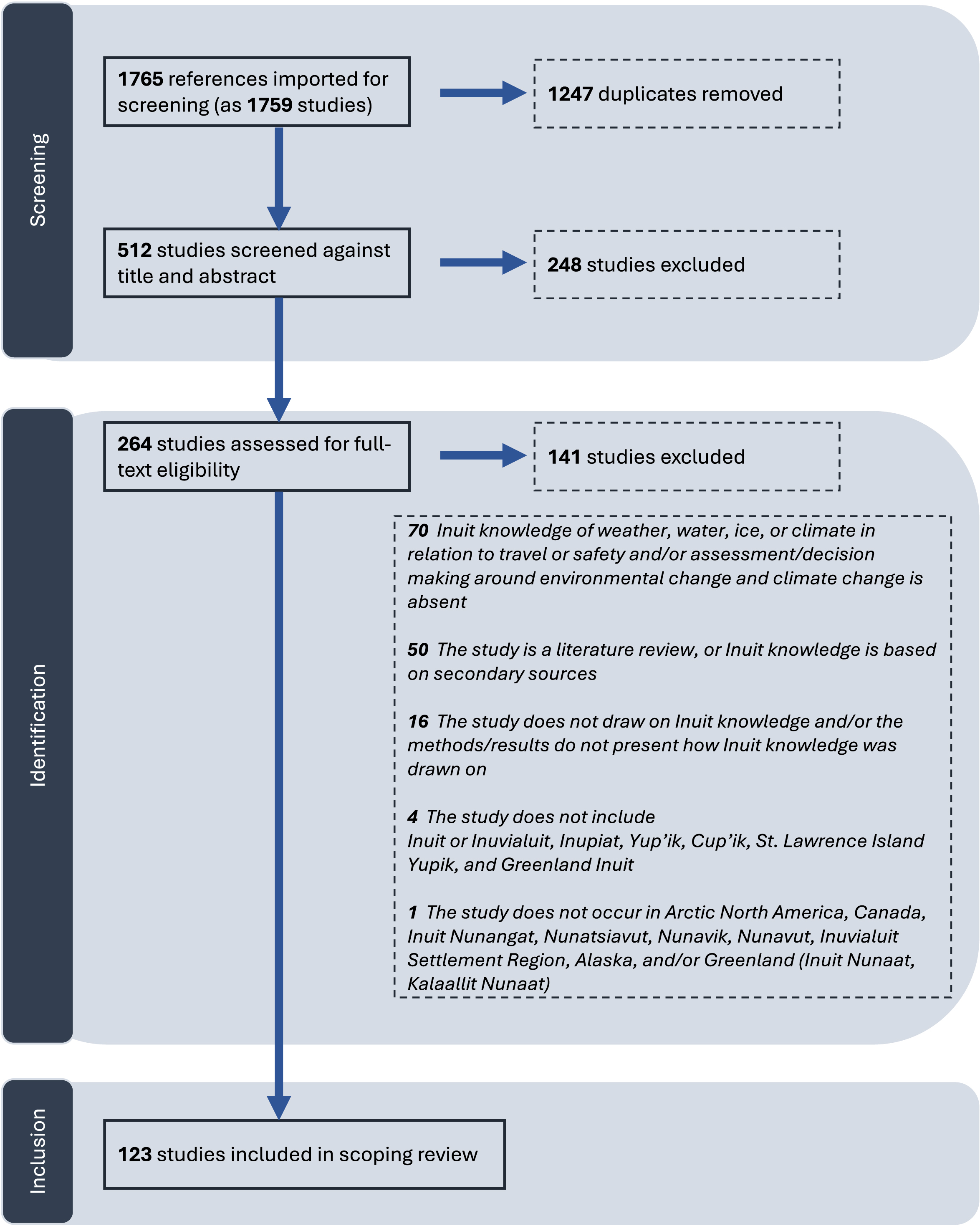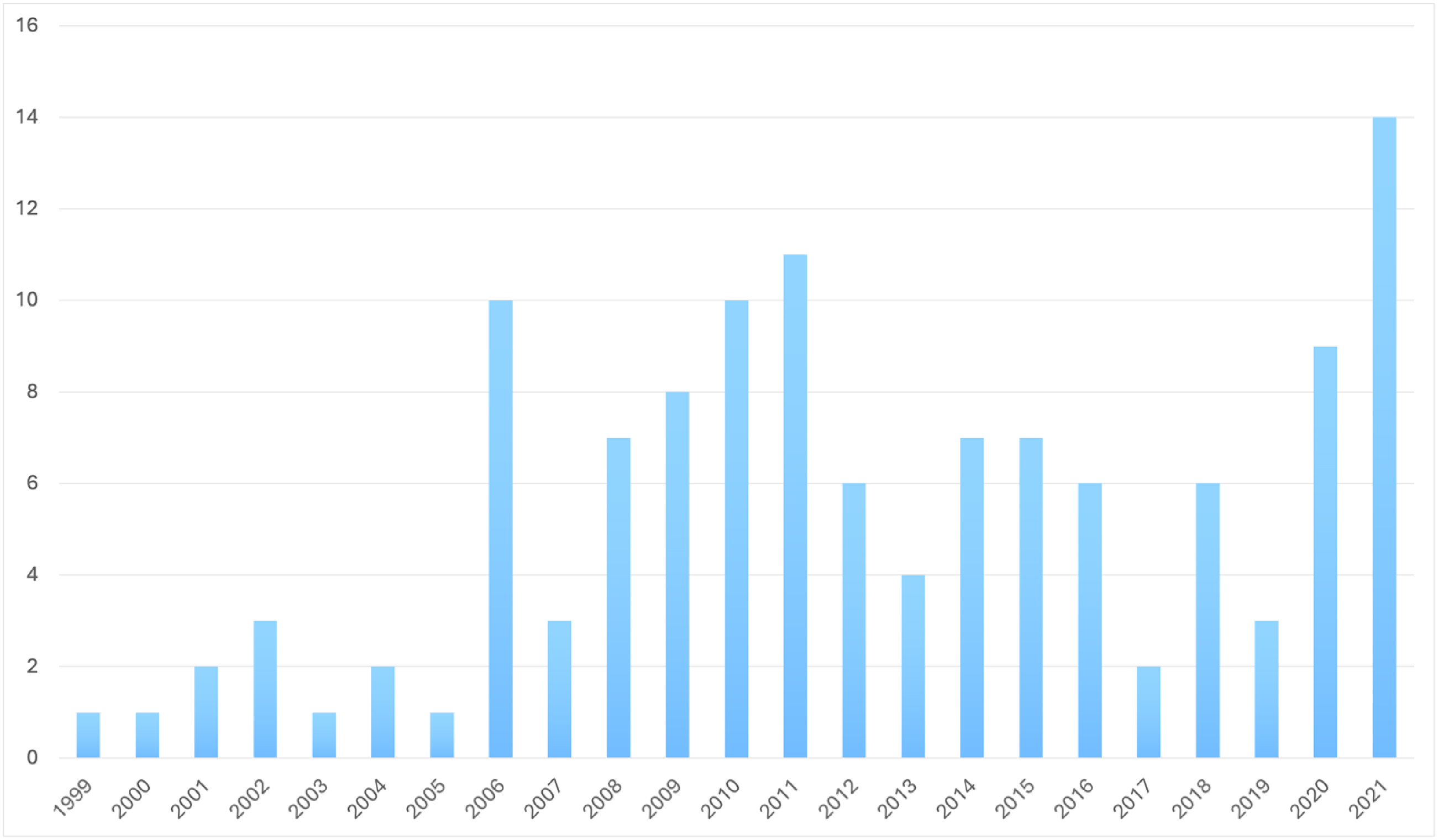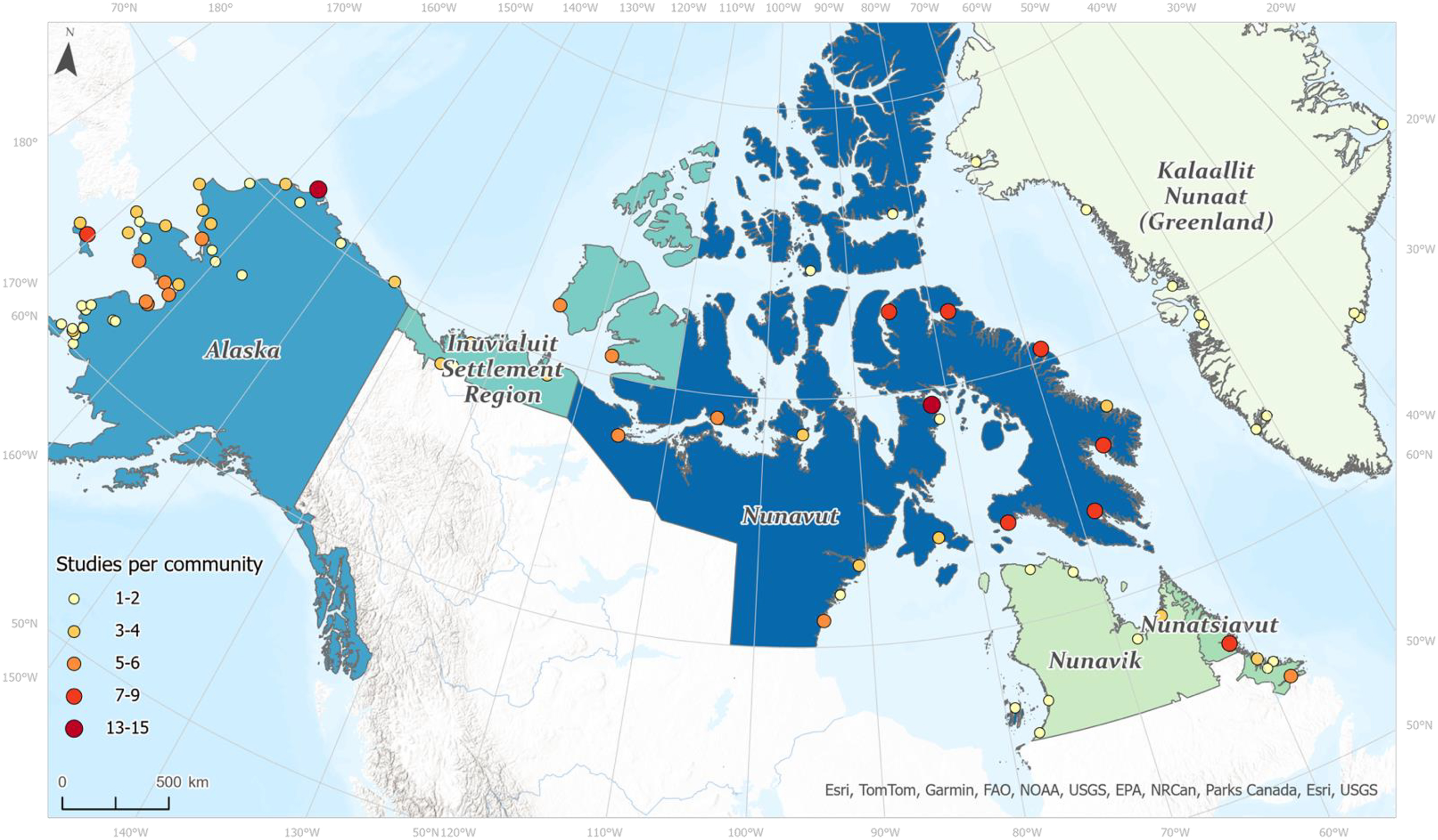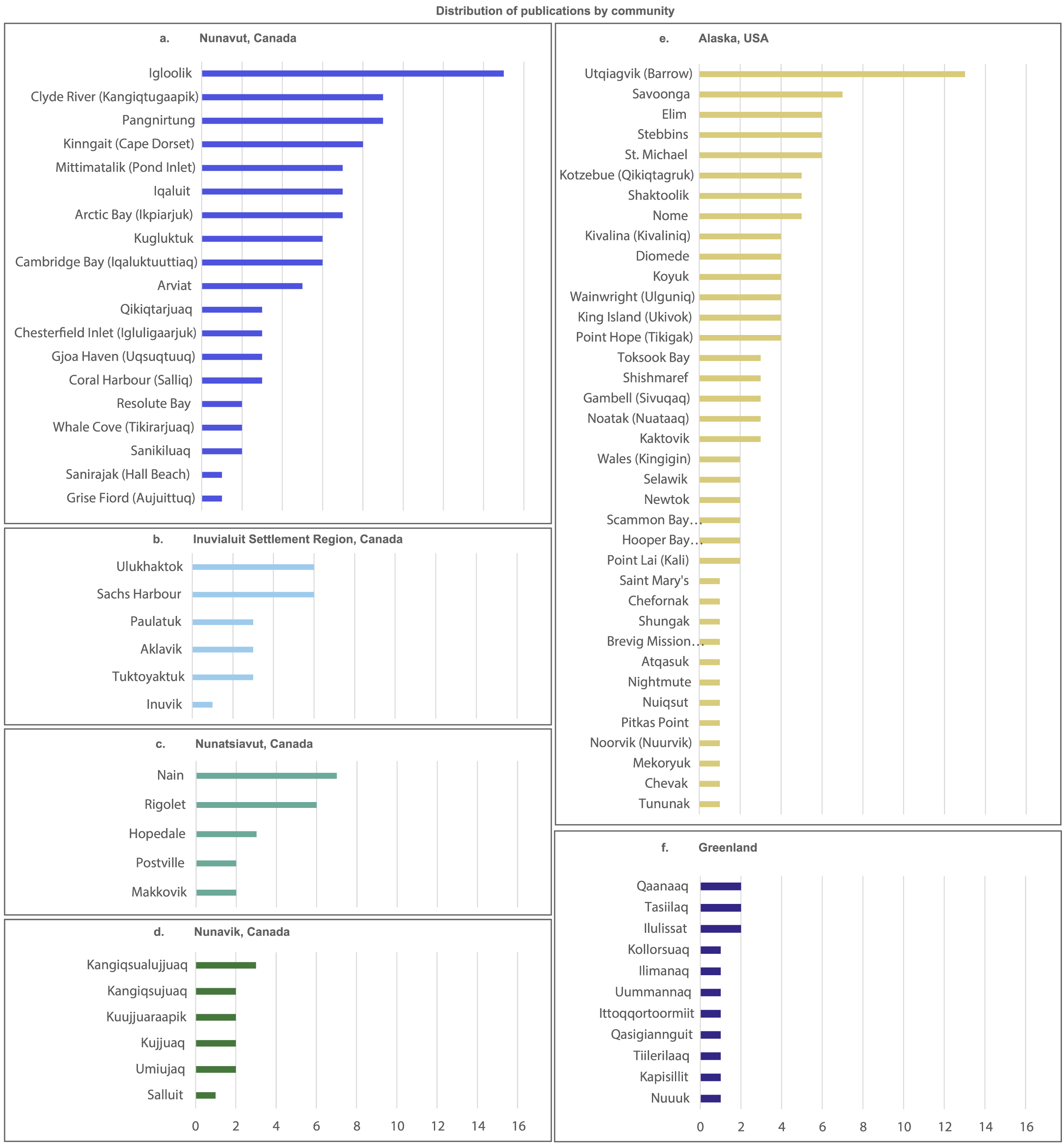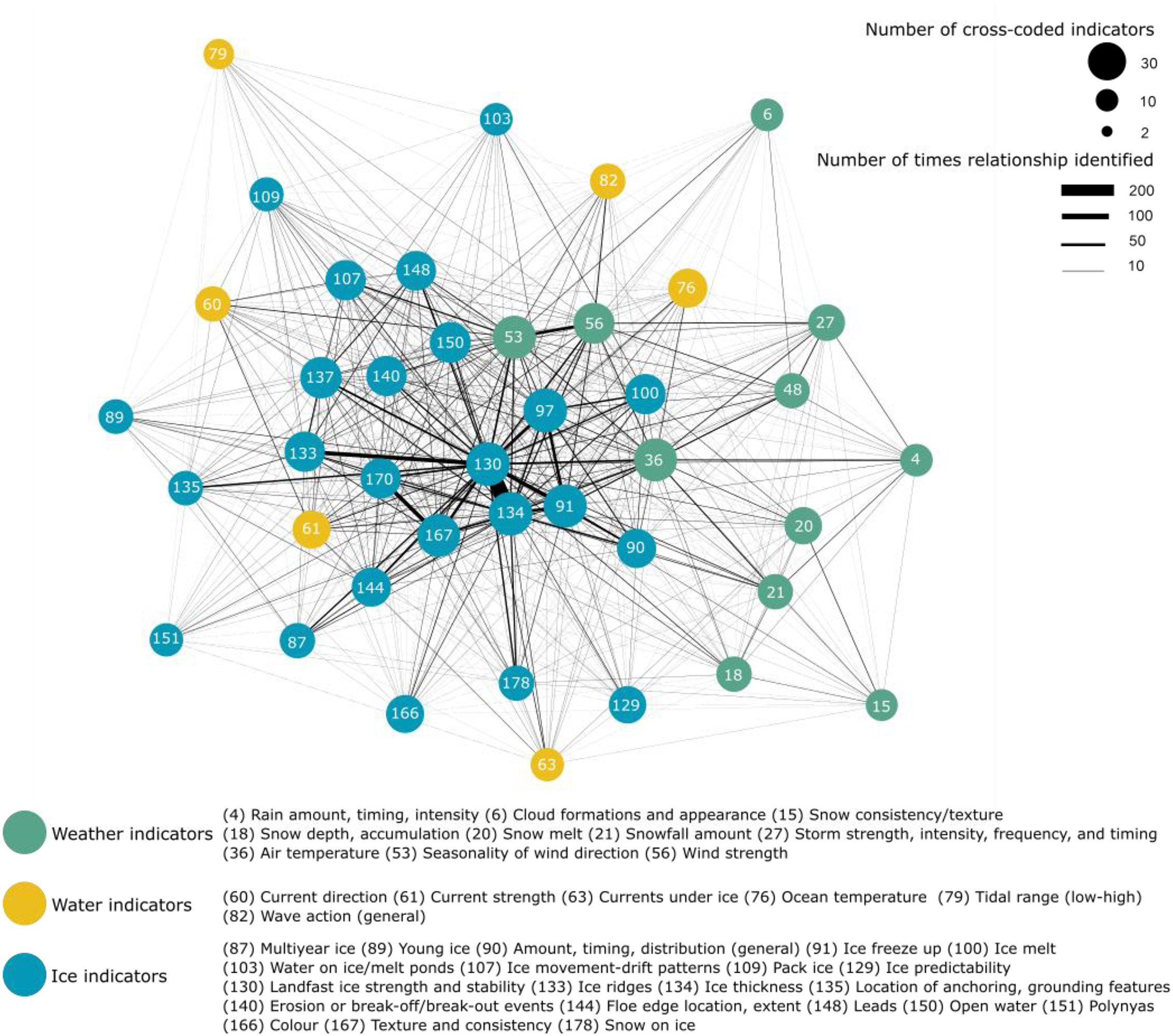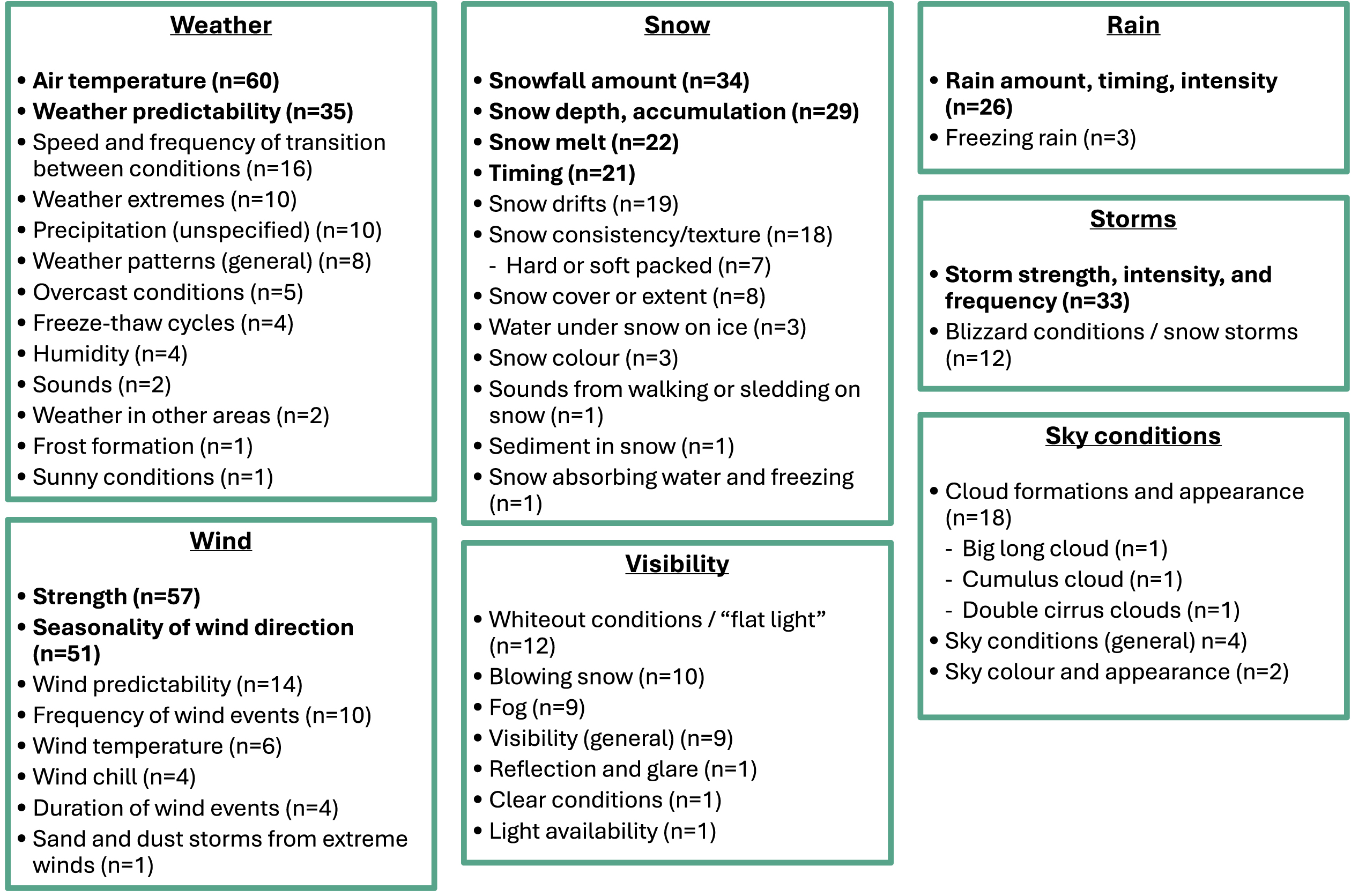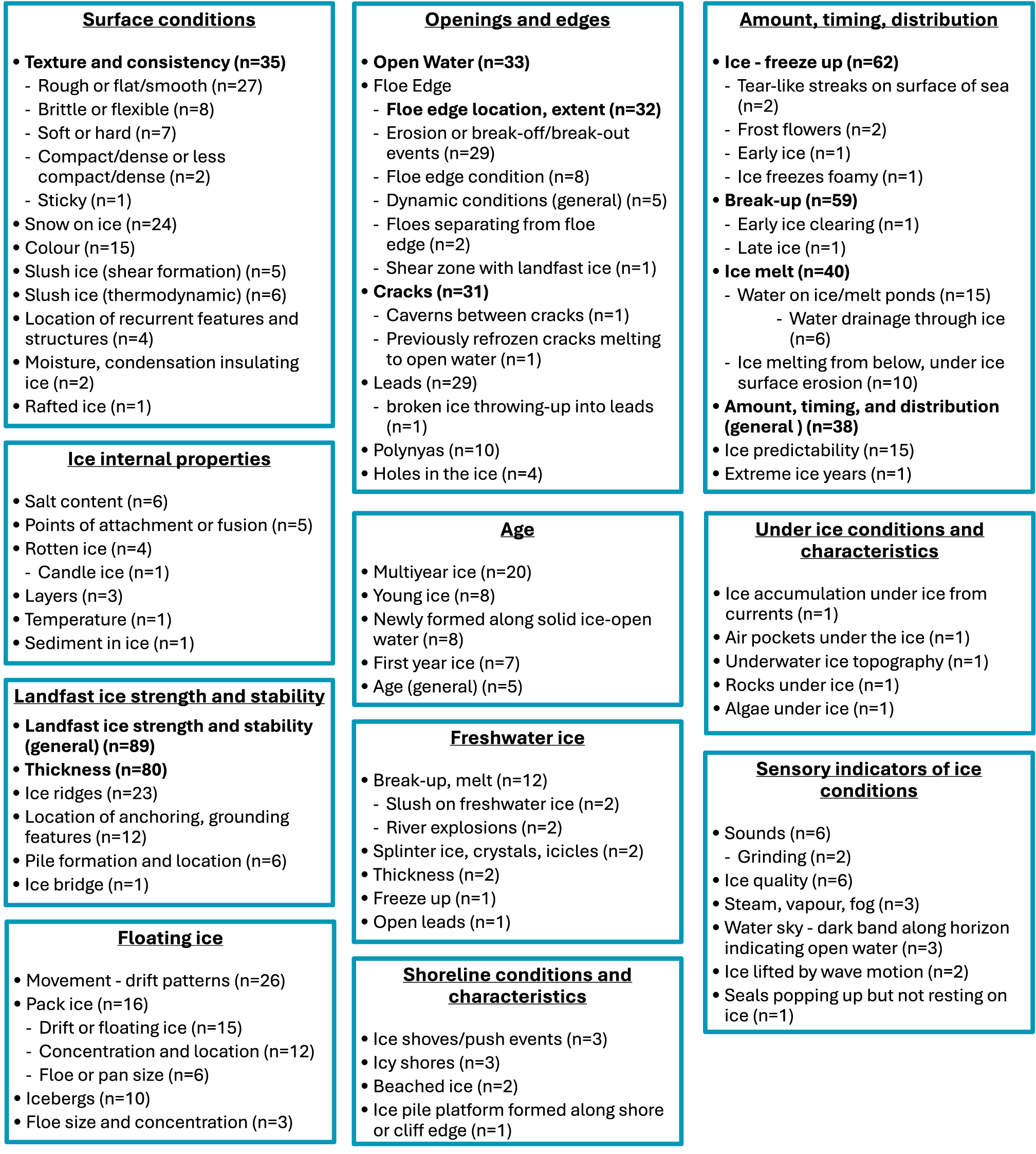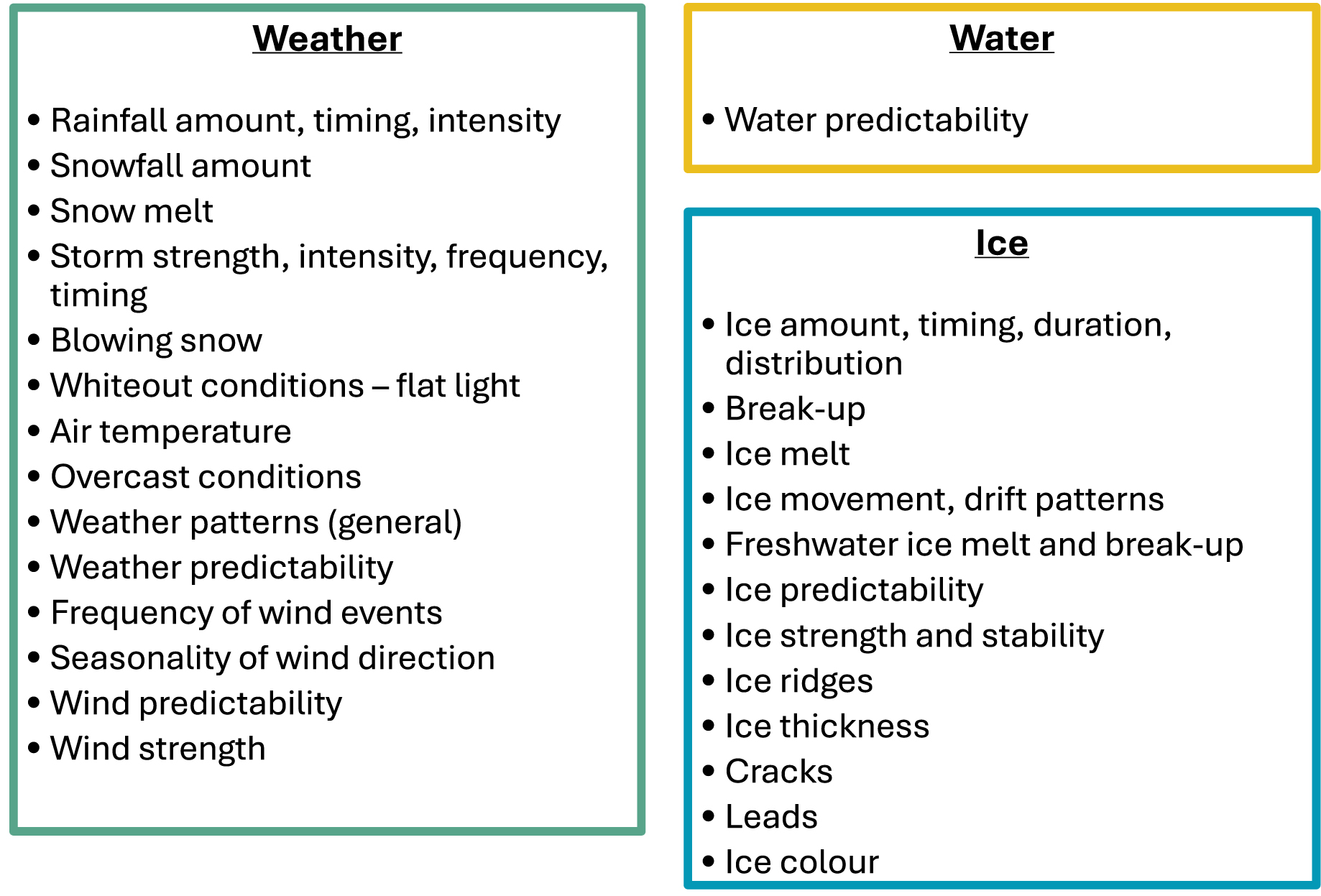4.1. Distribution of WWIC research intensity
Inuit Knowledge, as recorded and presented in the publications reviewed, emerges from research that was based in 85 communities throughout Inuit Nunaat. This involves knowledge of place- and context-specific indicators that hold value at certain spatial and temporal scales of mobility on the land, as conveyed by participants in the related research projects. Our research reveals an uneven distribution of research intensity and related volume of publications reporting Inuit Knowledge of WWIC, with some communities and regions being disproportionately represented in the breadth of indicators presented in our review (
Figs. 3–
4). For example, 54% of all publications reviewed were associated with Nunavut, while Alaska was associated with 25%, and other Inuit regions were associated with between 7% and 11% of the reviewed publications. Inuit Knowledge from Igloolik, Nunavut and Utqiagvik (Barrow), Alaska was reported in 15 and 13 publications respectively, all other communities were associated with ≤ 9 publications (and the majority being represented in ≤ 6). There were limited publications stemming from Greenland and Nunavik, and less than 40% of WWIC indicators identified were associated with Greenland, Nunavik, and Nunatsiavut. While some research limitations listed in
Section 2.4 may have impacted these numbers, a clear discrepancy remains. The implication of the uneven geographic variation in publications is that what we presented does not represent the full scope and context of WWIC indicators used in different Inuit regions and communities. The reported indicators likely reflect WWIC conditions experienced in regions/communities with a higher volume of associated publications. For example, out of all weather, water, and ice indicators identified in the publications we reviewed, 84% of ice, 86% of water, and 96% of weather indicators were described by Inuit in Nunavut. In contrast, 24% of ice, 36% of water, and 35% of weather indicators were described by Inuit in Greenland. This could imply that the indicators presented here bias towards those that are most relevant for Inuit in Nunavut. However, it is important to note that any communities not identified or regions and communities that were under-represented in our review may still use the extent of WWIC indicators in the results. As such, the WWIC indicators presented here cannot be considered comprehensive, but they can provide a broad baseline around which future research, monitoring, and/or forecasting can be developed. Such initiatives could aim to work with communities not identified through our review, or communities and regions that are under-represented (
Petzold et al. 2020). Assessing the relevance of the WWIC indicators amongst Inuit communities and regions would help develop a more inclusive understanding of indicator use across Inuit Nunaat. Ultimately, it is essential to account for community-to-community and region-to-region differences as well as commonalities to achieve a more comprehensive understanding of regional dynamics and indicator relevance.
4.2. Interconnected assessments of WWIC
Weather, water, and ice conditions are time- and place- specific. The ice and water indicators identified through our review (
Figs. 8–
9) largely reflect the conditions of a platform upon which Inuit travel—one that connects people, animals, land, and sea (
Aporta et al. 2018). Weather, in contrast, creates the conditions through which Inuit can or will travel, which in-turn influences the perceived quality of ice and water as a platform for travel (i.e., the conditions that may be encountered). Changes in weather, water, and ice are experienced first-hand and closely observed through day-to-day activities. In contrast, climate change has been framed as a more abstracted scientific concept (
Ingold and Kurtilla 2000;
Riedlinger and Berkes 2001). This abstraction could be linked to why a distinct “climate” indicator category was not identified. However, descriptions of predictive indicators and those associated with changing (reduced) predictability can convey where climate change impacts are being noticed more frequently. Relationships among weather, water, and ice indicators that once held true (trends over time) are no longer as predictable as they once were (indicative of changes to trends over time). These have the potential to be constructed as climate indicators. However, future research is warranted to explore this conceptualization further in collaboration with Inuit communities.
The importance of the WWIC indicators presented here is grounded in how Inuit perceive and understand their relationships with other conditions, which collectively influence travel safety and decision-making. Inuit Knowledge is the culmination of many generations of experiences within the Arctic climate system (
Itchuaqiyaq 2023). While individual “components” of the climate system have direct impacts on travel safety, the ability to make decisions and understand the environment is predicated on understanding and assessing the system as whole. Cross-coding of indicators revealed an inherent relationality in how Inuit Knowledge of WWIC involves an integrated assessment of various conditions that influence specific indicators in causal, conditional, or predictive ways. Notably, these categories are not mutually exclusive, rather the nature of the relationship being described allows for causal, conditional, and/or predictive framing. For example, the season and the air temperature associated with
rainfall amount, timing, and intensity can determine whether hazardous conditions will develop (conditional), while increased
rainfall in the winter can lead to increased snowmelt, slush formation, and unstable ice conditions (causal, predictive).
For Inuit to understand WWIC conditions (and impacts to travel safety), it is not individual indicators alone but the interconnected relationships between elements of the climate system that must be interpreted (
Nichols et al. 2004). This highlights the unique approach of collecting and passing on information as highly meaningful “
environmental packages”, where the more relationships Inuit know, the more precise their observations and predictions can be (
Oozeva et al. 2004). For example, rather than looking at ice strength and stability alone, Inuit are also assessing how conditions such as current speed and wind direction influence ice thickness, which is then contextualized further by the reason why Inuit are travelling in the first place (e.g., hunting on ice or by boat). These relationships are nuanced, context-based, and reflective of Inuit ways of knowing-being-doing-accounting relationally (
McGrath 2018) which are deeply entrenched in processes of perceptually engaging with the environment (
Ingold 2011). Such a perspective allows for in depth familiarity with WWIC situated according to—and contextualized by—the temporal and spatial scales of Inuit mobility on the land.
4.3. Gaps and insights for future research, monitoring, and forecasting
Monitoring and forecasting programs that provide information services use various environmental variables to create products and services that provide long- or short-range forecasts at local and regional scales. These forecasts rely on various data sources including conventional in-situ stations and satellite observing systems to produce predictive system models. Effective monitoring and forecasting in Inuit Nunaat are challenged by biases in in-situ station coverage, with the Arctic having notably sparse coverage when compared to more temperate latitudes (
Cowtan and Way 2014;
Johnson et al. 2015;
Simonee et al. 2021). As such, the spatial and temporal coverage of many long-term assessment programs and long- and short-range forecasting products and services do not always correspond with WWIC conditions that impact Inuit living in coastal communities throughout Inuit Nunaat (
Eicken et al. 2021;
Fox et al. 2020;
Stewart et al. 2020). Because of this, they may not capture where Inuit travel, phenomena of importance to Inuit, or Inuit approaches to observing the environment (
Gearheard et al. 2010;
Huntington et al. 2004).
Weather stations, if present, are typically located at community airports, whereas Inuit travel outside of their communities and can encounter conditions that do not correspond with weather station observations (
Gearheard et al. 2010;
Ljubibic and Carter 2022). Arctic coverage can also be entirely absent from critical information services. For example, the Canadian weather radar network has stations located exclusively in southern Canada, providing radar coverage only surrounding the locations of those stations (
Voosen 2023). Some weather services provide hours-old or days-old information, while real-time information is critical for short-term planning and in the case of an emergency (
Simonee et al. 2021). Similarly, certain information services are not available during the seasons that are most relevant for Inuit communities. For example, marine forecasts are only available during the marine shipping season, but that information would be very useful for communities year-round (
Ljubicic and Carter 2022). Inadequate temporal and spatial coverage can be incredibly dangerous for people travelling on the land, where forecast accuracy can mean the difference between life and death (Way 2023, as cited in
Sanders 2023). The focus of environmental monitoring and forecasting programs may not be representative of how Inuit observe and experience their local environments (
Gearheard et al. 2010;
Huntington et al. 2004). For example, while wind speed and direction may be monitored, the potential for blowing snow, or other indicators that can conditionally emerge might be more important for Inuit when making decisions related to safe travel.
The mandate driving the provision of information services may also misalign with Inuit uses of the environment. For example, while sea ice and the ocean act as a platform (or highway) for Inuit to access subsistence resources, sea ice information services provided by organizations such as the Canadian Ice Service (CIS) have been developed to meet their federal mandate to support safe shipping in Arctic waters by avoiding hazardous ice (
Government of Canada 2022). Inuit have identified that sea ice charts are often inaccurate to local conditions, linked to the coarser spatial scale and an inadequate representation of ice thickness (concentration) or surface conditions (
Ljubicic and Carter 2022;
Segal et al. 2021;
Wilson et al. 2021a). The conceptual tensions arising from how information services are designed and delivered can amplify the inaccessibility and inaccuracy of information services used by Inuit throughout Inuit Nunaat. It is essential to understand Inuit perspectives on the relevant indicators, appropriate temporal and spatial scales, and uses for WWIC information to effectively tailor information services to meet the needs of Inuit communities.
Given the holistic Inuit approach to understanding and assessing the environment, some environmental indicators used by Inuit may not be suited to systematic uptake and use in Western applications. This might include certain predictive indicators that involve sensory engagement with the landscape, or conditional indicators that emerge from the confluence of other conditions which could be time and place specific. However, the results of our review outline the breadth of WWIC indicators used by Inuit to assess travel safety in Inuit Nunaat, giving researchers and information service providers the opportunity to learn from these indicators and the relationality amongst them.
Table 2 details the top 10 weather, water, and ice indicators identified in the highest volume of publications. These indicators appear to be common across most regions, are critical to safe travel, and are already included (or could readily be included) in established monitoring programs to improve the relevance of information services accessed and used in Inuit communities.
Practitioners can use our review to assess key indicators according to ease of prediction and degree of consistency across regions, which can help target the development of locally relevant research and information services. It will be critical to collaborate with communities to develop these programs. The results presented here come from various research contexts and can provide a starting off point for future collaborations aimed at increasing the accessibility of WWIC information services. This should include assessing the relevance and application of WWIC indicators through engagement with individual communities to better understand the extent of mobility on the land, indicator use/application, and what information is needed to support travel safety. The spatial/temporal application of indicators must also be assessed against currently available coverage, including those that are multi-scalar (e.g., wind) versus those that are location-specific (e.g., recurrent ice features such as polynyas or cracks).
Differing cultural perceptions of indicators must be addressed to effectively co-produce WWIC services. For example, Inuit notions of WWIC are not exclusively external environmental variables such as those favoured in Western environmental monitoring and forecasting. This difference in perception is exemplified by the Inuktitut term
sila, which is commonly translated to “weather” in Western research. For Inuit,
sila also embodies a permeating cultural and spiritual lifeforce which contextualizes human relations within broader ecological processes, including the weather (Leduc 2007). Reaching this level of understanding requires intentional engagement and conscious contextualization of Inuit Knowledge and experiences (
Itchuaqiyaq 2023). Our review made evident the depth and specificity of Inuit terminology used to describe various WWIC conditions and processes. Accordingly, our results highlight the value of researchers and information service providers dedicating adequate time to learning—and translating—local terminology and associated conceptual meanings (whether in an Inuit language, English, or otherwise). This is critical for effective communication, and importantly, to avoid misunderstandings or misinterpretation. Doing so can help communicate the meaning of WWIC indicators that are used within and across various communities in Inuit Nunaat, and better asses their suitability for potential up-take into WWIC research, monitoring, and forecasting initiatives.
Inuit travel to hunt, harvest, visit other communities, access resources and connect with ancestral homelands, all of which is important to situate and contextualize the 163 unique indicators that arose from this scoping review (
Aporta 2009;
Cunsolo Willox et al. 2013;
Davis et al. 2022). WWIC conditions are experienced in conjunction with ecological, social, cultural, political, and economic factors which collectively influence safe travel and access to the land (
Moerlein and Carothers 2012). For example, weather, water, and ice conditions can influence the availability and distribution of wildlife and the ability for Inuit to safely access hunting and harvesting areas (
Brinkman et al. 2016). However, the decision to travel may also be influenced by other socio-economic factors such as food security, the financial cost of a hunting trip, or the ability to take time off from work. In focusing on WWIC indicators, our review contributes to
one aspect of this broader assessment. Thus, future research could consider WWIC indicators and their capacity to influence decision making in relation to other social, cultural, political, and economic considerations which impact access and safety.
While indicators can serve as a jumping off point in developing locally relevant research and information services, there are extensive co-production efforts that researchers and practitioners working in Inuit Nunaat can learn from to generate more accessible and usable information services. Moving beyond isolated WWIC indicators to address relational and socio-ecological underpinnings of observing the environment,
Fox et al. (2020) discuss the value of human-relevant environmental variables (HREVs). HREVs are complex synthesis variables that are used in conjunction with social factors to inform safe travel (
Fox et al. 2020). Such an approach may help better translate the critical relationships that Inuit observe amongst various indicators, and the broader social, cultural, and economic determinants influencing travel safety. If co-developed, HREVs could become the focus of monitoring, forecasting, and prediction programs, or they may be used to help translate existing products and services to better communicate them in locally relevant terms. It is important to consider how WWIC indicators might be monitored relationally, where causal, conditional, or predictive indicator relationships are accounted for.
Pennesi et al. (2012) suggest establishing community-based weather hazard impact advisory groups as a format to bring together local and scientific weather knowledge and make information more accessible to communities. Creating such a group can help Western scientists connect directly with community members to understand how the information they produce is used, and how it may be better tailored to account for local experiences of travel hazards. Ultimately, this can support developing information services that combine Indigenous and Western forecasting, for example through a consensus approach or integrated probability forecasting (
Nyzadi et al. 2022;
Plotz et al. 2017). Co-producing information services in this way can increase local accessibility, relevance, and usefulness for Indigenous communities involved (
Nyzadi et al. 2022).
